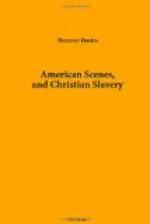In the evening I attended a Congregational church of coloured people. The place was exceedingly neat and clean. The minister, the Rev. Mr. Beman (himself a coloured man), gave out the well-known hymn—
“Come we that love the Lord,
And let our joys be known,” &c.,
which was sung beautifully. He then offered up a very judicious, sensible, and pious prayer. The meeting was one of a series of revival meetings. A large number professed to have been converted; but, such were the care and caution exercised, none of them had been admitted into the fellowship of the church. Mr. Beman was so prudent, unassuming, and devout, that I could not resist the inclination to go up, introduce myself, and give a short address. Most cordial was my reception, and great my enjoyment. At the close, one and another were introduced to me as having made their escape from Southern slavery, under circumstances painfully affecting; and they would not let me go without a promise that I would preach to them on the following Sabbath morning.
I did so, and enjoyed the service very much. As in the evening there was to be a service in the North Church, in which all the other churches were to unite, for the purpose of hearing from me a statement with regard to the history and operations of the London Missionary Society, together with some special reference to British Guiana, I said to Mr. Beman, “Brother Beman, won’t you and your people go to the North Church to-night?” He hesitatingly said, “No,—he thought not.” “Why not?” said I,—“you know my statements will in a great measure refer to those who are your brethren—your kindred according to the flesh.” “Yes,” he replied,—“we should be glad to come; but the fact is they would pack us—myself and all—into some negro pew, and we should feel it keenly.”
In the afternoon I preached for Mr. Dutton, in the North Church. Dr. Bacon had that day exchanged pulpits with Dr. Hawes of Hartford. My service closing a little sooner than his, I reached the Centre Church in time to hear the latter part of his sermon. Dr. Hawes is a fine, tall man, of about 55 years of age. In personal appearance, and in tones of voice, he struck me as greatly resembling some of the sons of Caledonia. His sermon, which was read, seemed to be very good; but the delivery, even in the application, was slow and heavy. Both churches were even more beautiful inside than out, and were filled with very large congregations.
Shortly after, Mr. Dutton took me to attend the afternoon worship at the College Chapel, where a church is formed, and public services are conducted every Sabbath. It was here that Dr. Dwight delivered his well-known Lectures. There are prayers morning and afternoon every day, which the students are expected to attend. Such was the present engagement. One of the professors read a chapter; gave out a hymn, which was magnificently sung; and then offered an extempore prayer. There were between 300 and 400 students present.




